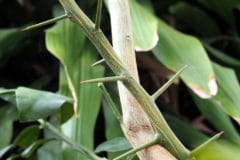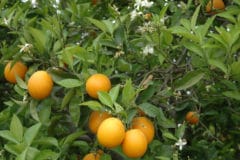First, What Does “Seedless” Mean?
Very rarely, a seed or two may hide in a navel orange. Commercial growers are legally permitted to label any fruit having between zero and six seeds as “seedless.” Navel oranges aren’t the only citrus to qualify for the honor; other sparsely seeded varieties include:
- Satsuma oranges (Citrus unshiu, USDA zones 8 through 10).
- Clementines (Citrus x clementina, USDA zones 8 through 11).
- Persian limes (Citrus latifolia, USDA zones 9 through 11).
- Kishu mandarins (Citrus kinokuni mukakukishu, USDA zones 9 through 11).
The location of the exact tree responsible for navel oranges has been lost to history. The most widely accepted account is that it grew from the mutated limb of a Bahia, Brazil Selecta orange tree between 1810 and 1820.
The Mutation
Selecta oranges typically contained 15 to 20 seeds, but the fruit from this branch averaged just nine. Embedded in the peel at the base of each fruit was an under-developed “twin” consisting of several smaller edible segments. It resembled a protruding navel.
Saving the Mutation
To preserve the low-seed trait, the growers grafted navel-fruited branches from the Select tree to similar rootstock. The rootstock fed the branches and the branches grew into fruiting orange trees. Through their selection of cuttings, the growers gradually reduced the oranges’ seediness. To this day, all commercial navel orange trees are grafted.
Why No Seeds?
Every spring, a navel orange tree’s branches are heavy with fragrant white flowers. It’s a pretty picture, but those flowers can’t make pollen and have no ovules that would develop into seeds. This ability to produce seedless, unfertilized fruit is called parthenocarpy.
Don’t count on finding a navel orange with a seed to plant. Even if you did, seed-started navels produce hybrid trees unlikely to replicate their parents. If you live in USDA zones 9 through 11, plant a nursery-started tree.
Give it full sun, well-draining soil, regular water and the right care and you’ll be snacking on seedless oranges in two or three years.












